A. Living Things
➢ All living things are composed of cells
➢ According to cell theory, the cell is life’s basic unit of structure and function
- Cell is the smallest unit of living material that can carry out all the activities necessary for life
➢ Why not be a GIANT CELL? - Specialization
- Must maintain high surface area:volume ratio to allow cellular exchanges across the membrane!
B. Types of Cells and Organelles
➢ Invention of electron microscopes allowed scientists to figure out the exact functions of cells
➢ Prokaryotic cells
- Only in domains Bacteria and Archaea
- Smaller
- Simpler
- Circular DNA
■ In nucleoid region
■ NO NUCLEUS - Cell wall
■ Made up of peptidoglycans that surround a lipid layer called the plasma membrane - Filled with semi-fluid cytosol
- Have ribosomes
- Can have flagella
■ Long projections used for motility - May have a thick capsule outside their cell wall to give them extra protection
- No membrane-bound organelles
➢ Eukaryotic cells - More complex
- Organized into smaller structures called organelles
- DNA in nucleus bounded by a membranous nuclear envelope
- Cytoplasm between plasma membrane and nucleus
C. Organelles
➢ Each organelle has its own special task
➢ Plasma Membrane
- Outer envelope
- Complex
- Phospholipid bilayer
- Encloses vacuole
- Regulates movement in/out of cell
- Flexible due to weak bonds holding it together
■ Higher fluidity when more phospholipids have double bonds (causing a bend in the tail) since the molecules aren’t as packed
- Semipermeable
■ Only small hydrophobic molecules can pass through unaided
■ Anything large/hydrophilic must pass through active/passive transport
■ Water can’t move through easily due to its polarity - Fluid-mosaic model
■ Peripheral proteins are loosely associated with the lipid bilayer
● Located on inner/outer surface of membrane
■ Integral proteins are firmly bound into the plasma membrane
● Amphipathic to allow anchoring
● Some extend all the way through the membrane
■ Membrane peppered with different proteins/carb chains - Adhesion proteins
■ membrane proteins form junctions between adjacent cells - Receptor proteins
■ Serve as docking sites for arrivals at the cell
■ Ex. hormones - Transport proteins
■ Form pumps that use ATP to actively transport solutes across the membrane
■ Hydrophilic channel that certain molecules/ions can use as a tunnel
■ Specific for substance it moves - Carrier Proteins
■ Bind to molecules and change shape to shuttle them across the membrane
○ Channel proteins
■ Selectively allow the passage of ions/molecules
○ Cell surface marker
■ Exposed on cellular surface
■ Play a role in cell recognition/adhesion
■ Ex. glycoproteins - Carbohydrate side chains
■ Attached to surface of some proteins
■ Found only on outer surface - Cholesterol
■ Maintain fluidity (see pg. 11)
■ Unsaturated fats also lend membrane fluidity by increasing space between phospholipids due to bend
- Semipermeable
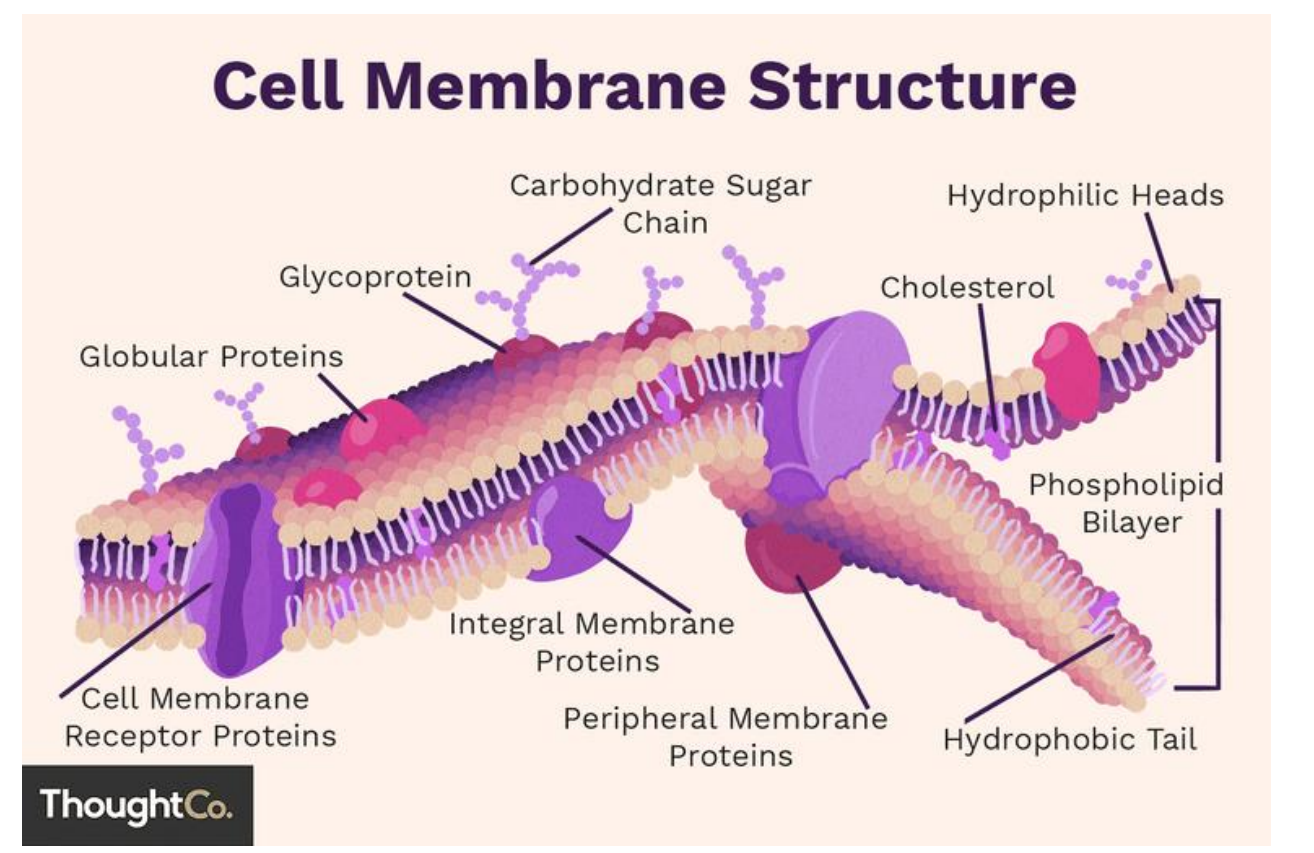
➢ Nucleus
- Largest organelle of cell
- Directs what goes on in cell
- Responsible for cell’s ability to reproduce
- Home of hereditary information (DNA)
■ DN organized into large structures called chromosomes - Most visible structure of nucleus id nucleolus, which is where rRNA is made and ribosomes are assembled
➢ Ribosomes - Sites of protein synthesis
- Manufacture all proteins required/secreted by the cell
- Consists of RNA and other proteins
- Bind messenger RNA and transfer RNA to synthesize proteins
- Round structures consisting of 2 subunits:te large subunit and the small subunit
- Composed of RNA and proteins
- Can either be free floating or attached to the endoplasmic reticulum (ER)
➢ Endoplasmic Reticulum (ER)
- Continuous channel that extends into many regions of the cytoplasm
- Lipid proteins synthesis/transport
- Rough ER
■ Attached to nucleus
■ Studded with ribosomes
■ Proteins generated here are trafficked to/across plasma membrane, or used to
build Golgi bodies, lysosomes, or the ER. - Smooth ER
● Lacks ribosomes
● Makes: - Lipids
- Hormones
- Steroids
● Breaks down toxic chemicals
➢ Golgi Bodies - Process proteins
- Once the ribosomes on the rough ER have completed synthesizing proteins, the Golgi
bodies modify, process, and sort the products - packaging/distribution centers for materials destined to be sent out of cell
- Package final products into vesicles
■ Carry products to plasma membrane - Involved in production of lysosomes
➢ Mitochondria - “Powerhouse of the ceil”
- Responsible for converting the energy from organic molecules into useful energy for the cell
- Energy molecule in the cell is adenosine triphosphate (ATP)
- Unique oblong shape and characteristic double membrane consisting of an inner portion and an outer portion
- Inner membrane forms folds called cristae
■ Separates innermost area (called the matrix) from the intermembrane space
■ Outer membrane separates the intermembrane space from the cytoplasm
■ Production of ATP done on the cristae
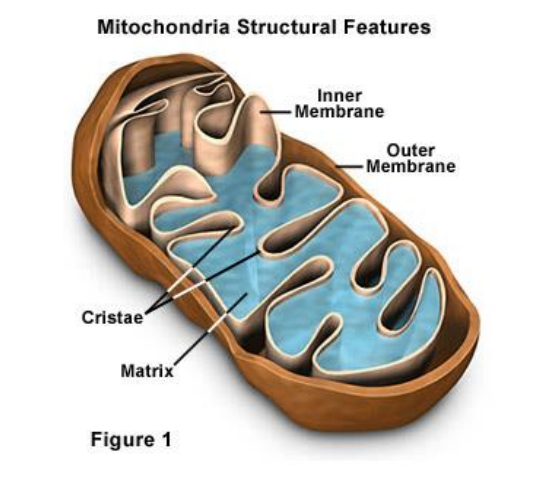
➢ Lysosomes
- Tiny sacs that carry digestive enzymes
- Break down old/worn out organelles/debris/large ingested particles
- Cells clean-up crew
- Keep cytoplasm clear of unnecessary flotsam
- Sometimes contain hydrolytic enzymes that function only at an acidic pH, which is enclosed inside the lumen of the lysosome
➢ Centrioles
- Small. Paired, cylindrical structured often found within microtubule organizing centers (MTOCs)
- Most active during cellular division
■ When cell is ready to divide, centrioles produce microtubules, which pull the replicated chromosomes apart and move them to opposite ends of the cell - Common in animal cells but not in plants
➢ Vacuoles
- Latin for “empty cavity”
- Fluid-filled sacs that store water/food/wastes/salts/pigments for later use/removal
- Larger in plant cells
➢ Peroxisomes
- Breakdown of long fatty acids through beta-oxidation
➢ Cytoskeleton
- Network of fibers that maintain cell shape
- Most important:
■ Microtubules
● Made up of protein tubulin
● Participate in cellular division/movement
● Integral part of centrioles/cilia/flagella
■ Microfilaments
● Important for movement
● Composed of protein actin
● Actin monomers joined together and broken apart as needed to allow
microfilaments to grow and shrink
● Assist during cytokinesis/muscle contraction/formation of pseudopodia - extension during cell movement
➢ Cilia and Flagella
- Allow motion in single-celled organisms
- In respiratory tract, cilia sweep constantly back and forth to keep out pathogens/dust
- Every sperm cell has flagellum, enabling it to swim through the female reproductive organs to fertilize the waiting ovum
➢ Extracellular matrix
- Molecules secreted by cell
■ Mostly glycoproteins or other carb/containing molecules, esp. collagen - Provides structure/biochemical support
➢ Plant Cells vs. Animal Cells
- Plant have plasmodesmata
■ Connections between plant cells that allow communication amongst them - Plant cells have cell wall
■ Rigid layer of cellulose
■ Outside of plasma membrane
■ Provides support for cell
■ Prevents lysis - Plant cells have chloroplasts
■ Contain chlorophyll, making them green
■ Involved in photosynthesis - In plants, most of cytoplasm taken up by enlarged vacuole that crowds out other organelles
■ Contains cell sap in mature plants
■ Full vacuole means plant is not dehydrated - Plants do not contain
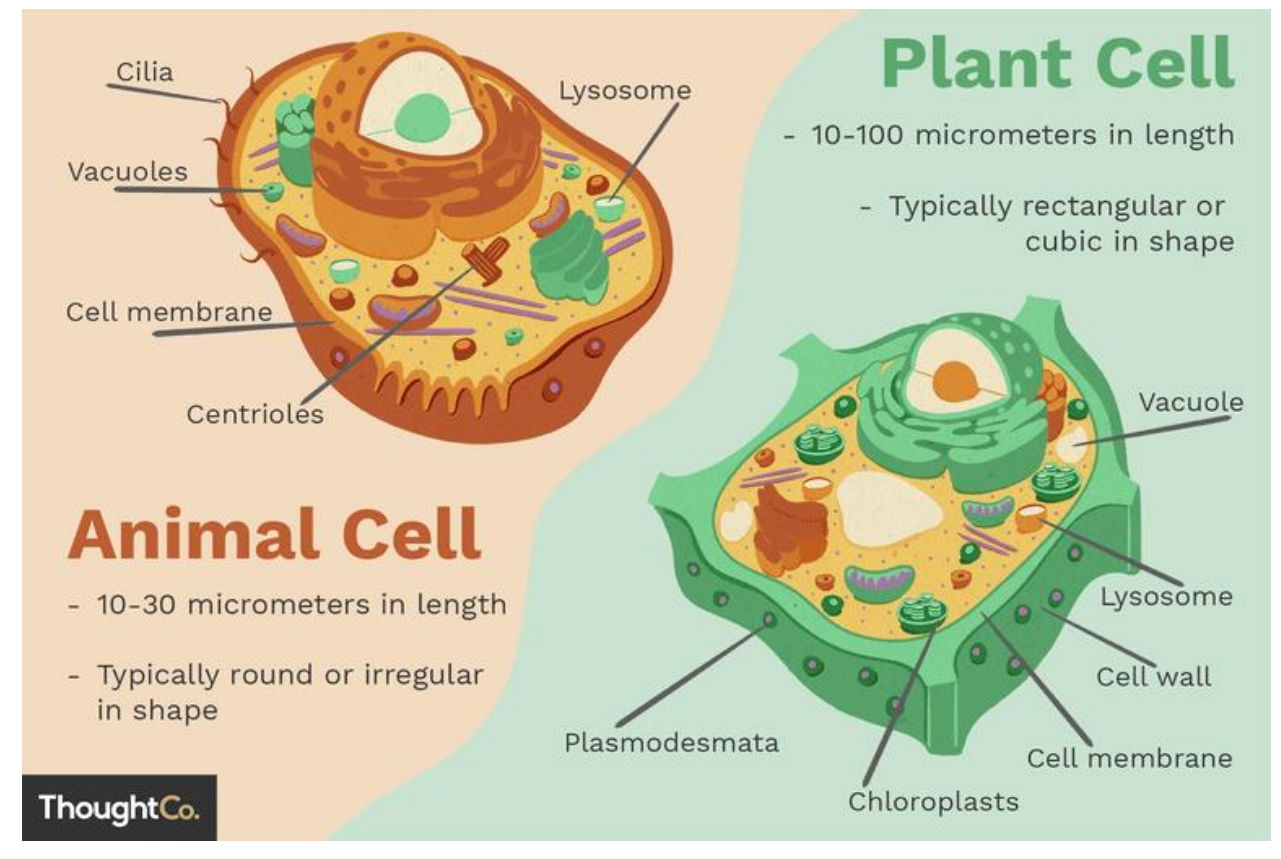
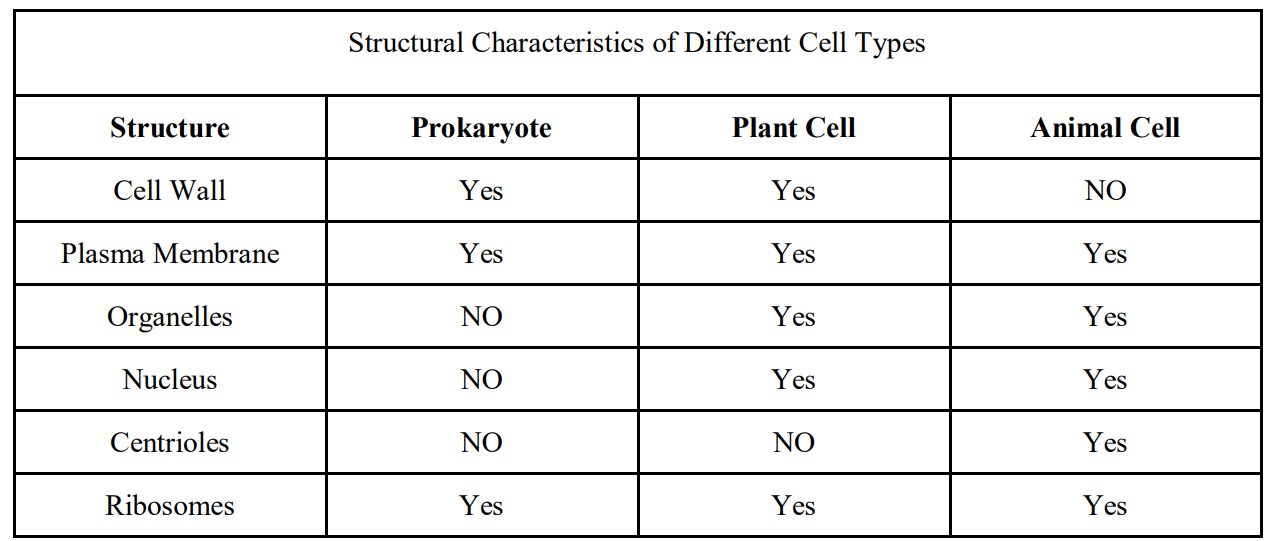
D. Transport Across the Plasma Membrane
➢ Ability to travel across the plasma membrane depends on (1) semipermeability of the plasma membrane and (2) the size and charge of the molecules that want o get through
➢ Lipid-soluble substances can cross the membrane easily due to the phospholipid tails of the membrane
- “Like dissolves like”
➢ Facilitated transport
- Substances must pass through a specific channel protein instead of directly through the
membrane due to its hydrophilic/charge/etc. - Depends on a number of proteins that act as tunnels through the membrane
- Ex.:Aquaporins are water specific-channels
➢ Simple transport: Simple and facilitated diffusion
- Diffusion
■ A substance will move down its concentration gradient - Simple Diffusion
■ If the diffusion molecule is hydrophobic, the nonpolar molecule can drift through
the membrane unaided - Facilitated Diffusion
■ Diffusion of a substance requires the help of a channel protein
■ Called passive transport when that substance is moving down its concentration gradient
● No energy required
● At Dynamic equilibrium, as many molecules cross the membrane in one direction as the other
➢ Osmosis
- Process where water is diffused
- Water always moves from areas where it is more concentrated to where it is less concentrate
■ Water moves to dilute solid particles - In both diffusion and osmosis, the final result is that the solute concentrations are the same on both sides of the membrane. The only difference is that in diffusion that membrane is usually permeable to the solute, and in osmosis it is not
- Tonicity describes osmotic gradients
■ A Isotonic solution, the solute concentration is the same inside as outside
● No net water movement
■ A hypertonic solution has more total dissolved solutes than the cell
● Cell loses water
■ A hypotonic solution has less total dissolved solutes than the cell
● Cell gains water
■ Cell walls help maintain water balance
■ A plant cell in a hypotonic solution swells until the wall opposes uptake, becoming turgid/firm; while an animal cell in a hypotonic solution will lyse/burst since their membrane are not as string
■ Plant cells experience lethal plasmolysis in a hypertonic environment
■ Plant cells become flaccid in an isotonic environment
➢ Water potential$(Ψ)$ is the measure of potential energy in water and describes the eagerness of water to flow from an area of high water potential to an area of low water potential
- Affected by pressure potential $Ψ_p$ and solute potential $Ψ_s$
- Equations on AP sheet
➢ ACtive Transport
- Allows a substance to move against its concentration gradient by using energy to help it along
- Performed by specific proteins along membrane
- Ion Pumps
■ Membrane potential=voltage difference across a membrane
● Voltage created by difference in the distribution of positive/negative ions
across a membrane
■ 2 combined forces (electrochemical gradient) drive diffusion of ions across a membrane
■ Electrogenic pump is a protein that generates voltage across a membrane
■ Ex ∴ Sodium-potassium pump
● Pushes out $3 Na^{+}$ and brings in two $K^{+}$
● Depends on ATP
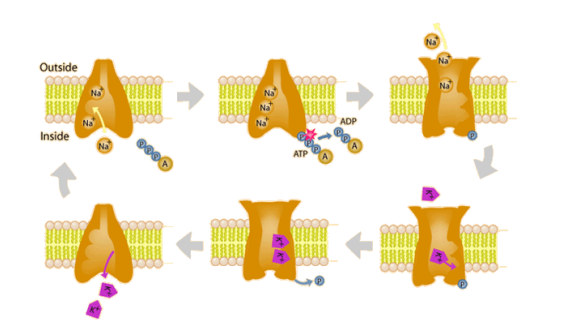
■ Cotransport occurs when active transport of a solute indirectly drives transport of other solutes
- Primary active transport directly uses ATP to transport something
- Secondary active transport occurs when a substance is moved across its concentration gradient by using the energy captured from the movement of another substance passively moving along its concentration gradient
➢ Endocytosis
- When the particles that want to enter a cell are too large to be transported by a channel protein, the cell uses a portion of the membrane to engulf that substance
■ Membrane forms a pocket, pinches in, and eventually forms a vacuole/vesicle - 3 types
■ Pinocytosis
● Ingests liquids
■ PHagocytosis
● Ingests solids
■ receptor -mediated endocytosis
● Cell surface receptors work with endocytic pits that are lined with a protein called clathrin
● When a ligand binds to one of these receptors, it is brought into the cell by invagination (“folding in”) of the cell membrane
● Vesicle forms around incoming ligand and carries it to cell’s interior
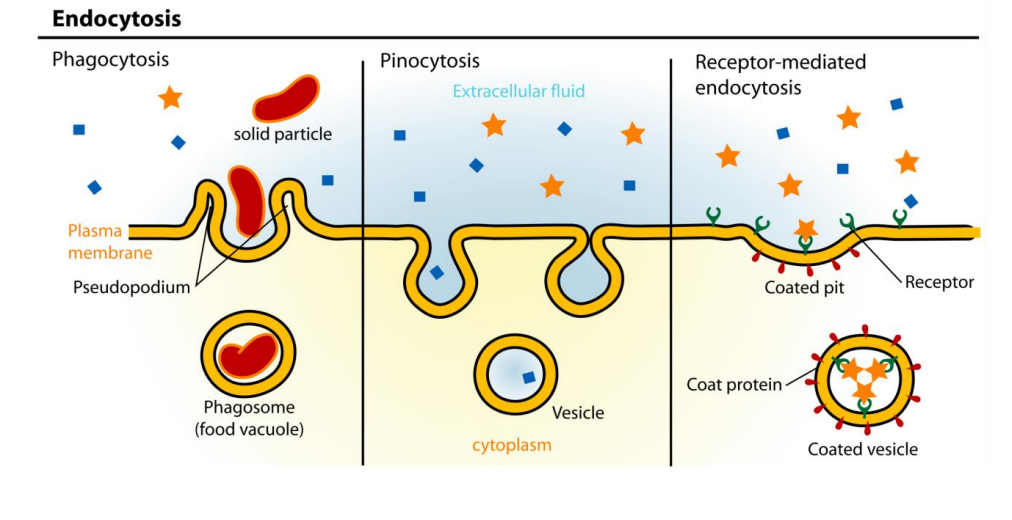
■ Exocytosis
- Large particles transported out of cell ex. Waste, specific secretion products (like hormones)
- `fusion of a vesicle with plasma membrane
- Reverse endocytosis
➢ Bulk Flow
- One-way movement of fluids brought about by pressure
- Ex. movement of blood through a blood vessel
➢ Dialysis
- Diffusion of solutes across a selectively permeable membrane
➢ Cell Junctions
- Result of cells in close contact with each other
- Allow neighboring cells to form strong communication connections/nutrient flow
- Fastens cells to each other
- Provide contact between neighboring cells or cell and extracellular matrix
- 3 types
■ Desmosomes
● Hold adjacent animal cells tightly together
● Pair of discs associated with the plasma membrane of adjacent
cells+intermediate filaments within cells that are also attached to discs
■ Gap junctions
■ Protein complexes that form channels in membranes and allow communication between cytoplasm of adjacent animal cells for the transfer of small molecules/ions
■ Tight junctions
■ Tight connections between membranes of adjacent animal cells
■ So tight that there is no space in between cells
■ Seal off body cavities
■ Prevent leaks
➢ Cell Communication
- Involves transduction of stimulatory/inhibitory signals from other cells/organisms/environment
- Quorum sensing is when unicellular organisms make their numbers known to other members of their species
- Taxis is the movement of an organism in response to a stimulus
■ positive=movement towards stimulus
■ negative=movement away from stimulus
■ Chemotaxis is movement in response to a certain chemical
● Ex.: - Bacterial can control flagella rotation to avoid repellents/find food
- Used by neutrophils to respond to an infection
- Signalling can be short range (nearby cells) or long range (throughout organism) 28
■ Done by cell junctions/ligands - Cell’s response to an extracellular signal sometimes called the “output signal”
- Signal transduction is the process by which an external signal is transmitted to the inside of a cell
■ 1. RECEPTION
● A signalling molecule binding to a specific receptor
● Intracellular or extracellular
● Even the same signal can have different effects in cells with different proteins and pathways
● Pathway branching and “cross-talk” further help the cell coordinate incoming signals
■ 2. TRANSDUCTION
● Activation of a signal transduction pathway
● AMPLIFICATION
○ Phosphorylation cascade
■ one enzyme (kinase) phosphorylates another, causing a chain reaction leading to the phosphorylation of thousands of proteins
■ At each step, the number of activated products is much greater than in the preceding step
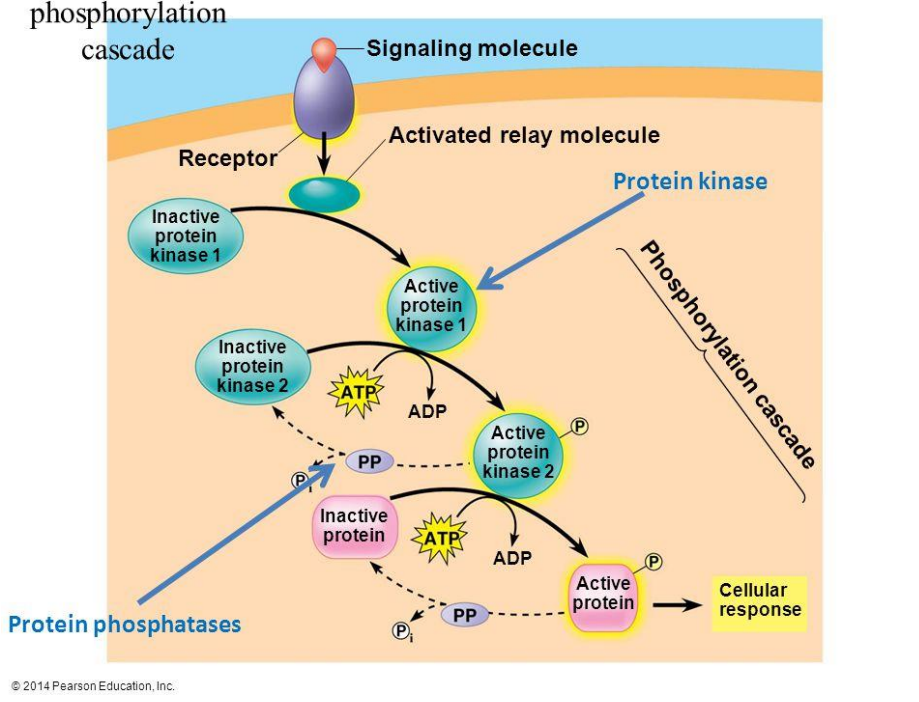
● Scaffolding proteins are large relay proteins to which other relay proteins are attached; increase signal transduction efficiency by grouping together different proteins involved in the same pathway
■ RESPONSE
● Affect gene expression
● Change enzymatic activity
● Apoptosis
- Programmed cell suicide
- Components of cell chopped up and packaged into vesicles which are digested by scavenger cells
■ Mostly done by caspases (main proteases (enzymes that cut up proteins) that carry out apoptosis) - Can be triggered by extracellular ligand, DNA damage, or proteins misfolding in ER
- Apoptosis evolved early in animal evolution
- Essential for development and maintenance if all mammals
- 3 classes of membrane receptors
■ Ligand-gated ion channels
● Ion channel is opened upon binding to a specific ligand
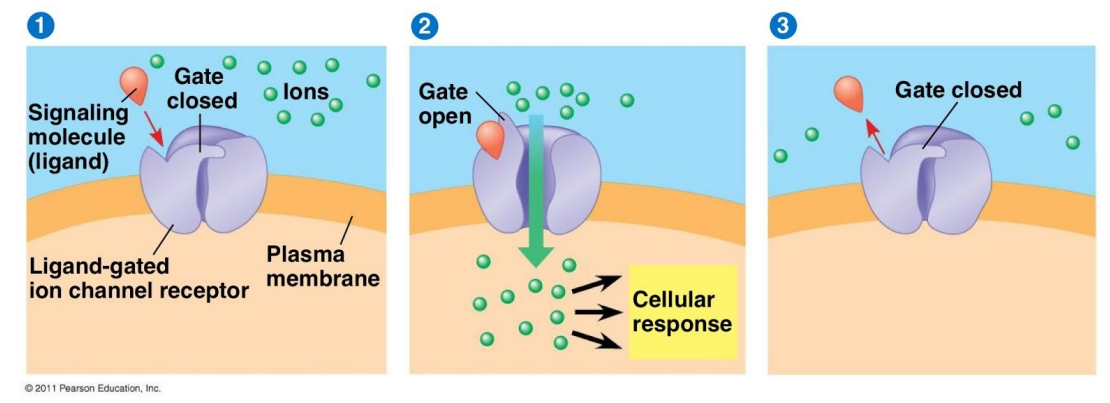
■ Catalytic receptors
● Aka enzyme-linked receptors
● Enzymatic active site on the cytoplasmic side of the membrane
● Initiated by ligand binding on the extracellular surface
■ G-protein coupled receptor
● Largest family of cell-surface receptors
● A GPCR is a plasma membrane receptor that works with the help of a G protein
- G protein acts as an on/off switch
■ If GDP is bound to the G protein, the G protein is inactive
■ Signal stopped by hydrolyzing GTP
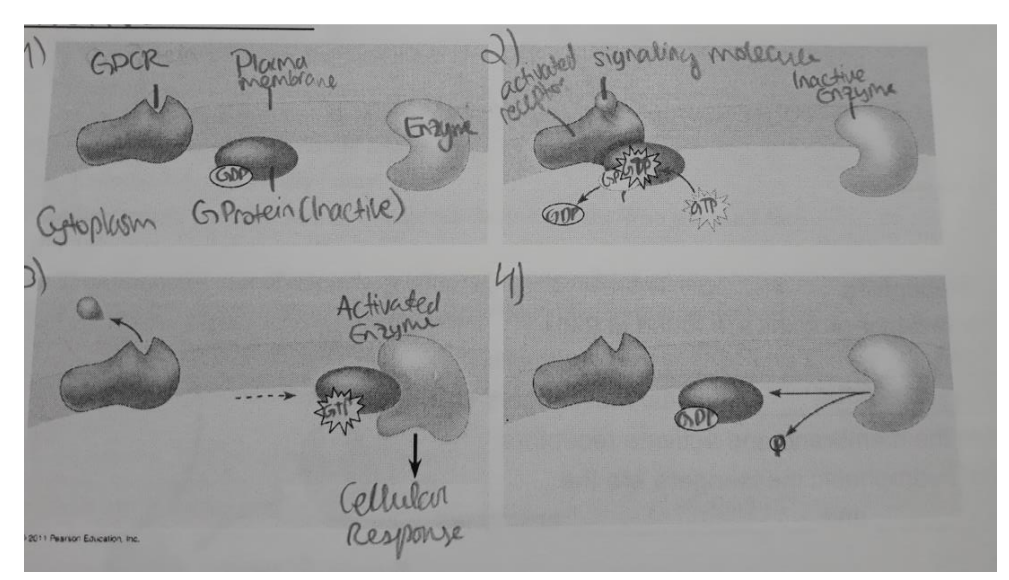
■ Receptor Tyrosine Kinases
● Membrane receptors that attach phosphates to tyrosines
● Can trigger multiple signal transduction pathways at once
● Abnormal functions of RTKS associated with many types of cancer
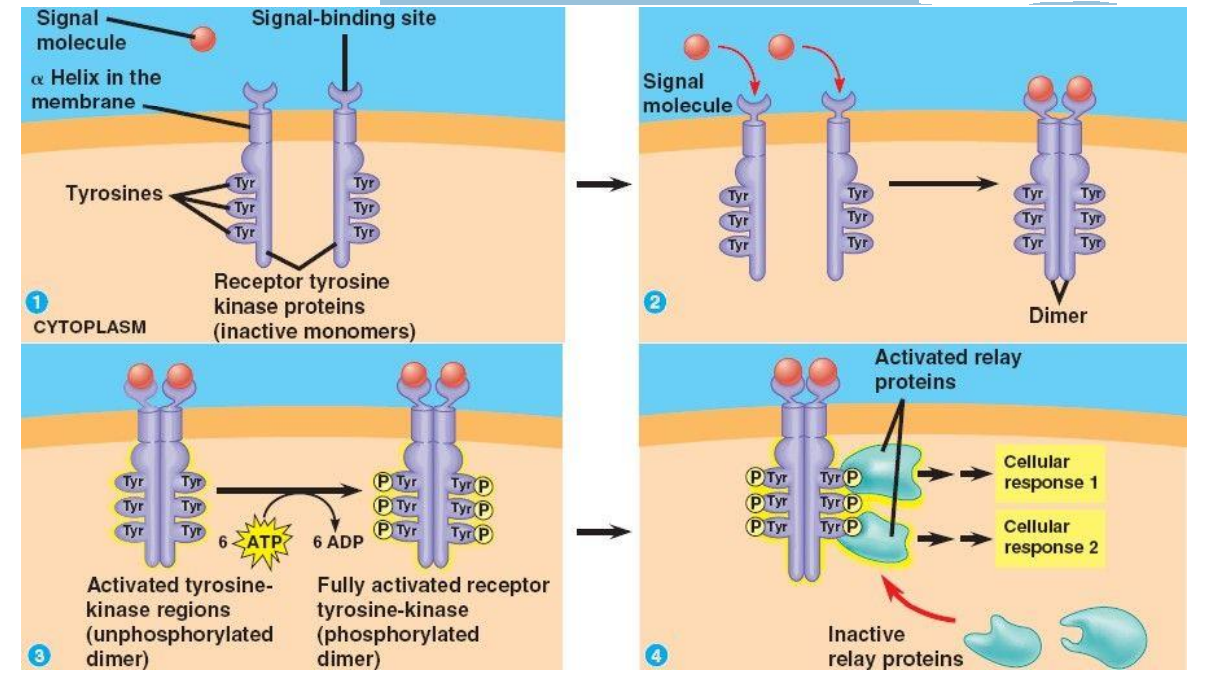
- Intracellular receptors
■ Small or hydrophobic messengers can readily cross the membrane and activate receptors in cytoplasm
● Ex. steroid/thyroid hormones of mammals
■ Secondary messengers diffuse easily into cell
● Can activaate a phosphorylation cascade
■ Can act as a transcription factor, turning on many genes - Signal transduction in eukaryotic cells usually involves many cells and complex regulation
■ Bacterial cells use a much simpler, 2-component regulatory system in transduction pathways - In plants
■ No nervous system, but can product several proteins found within them ex. Neurotransmitter receptors
■ Can generate electrical signals in response to environmental stimuli
■ Some plants can also use chemicals to communicate with nearby plants
